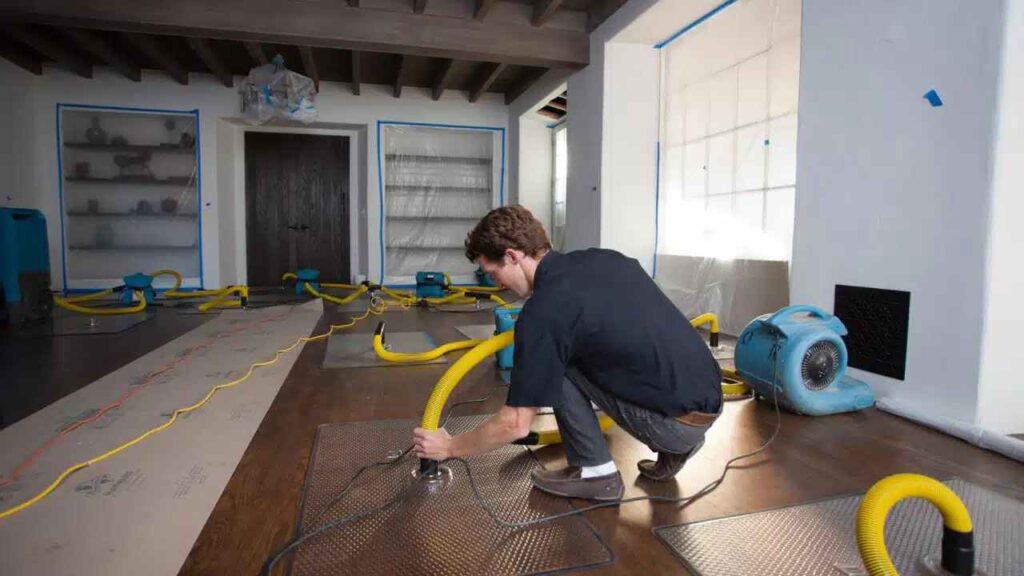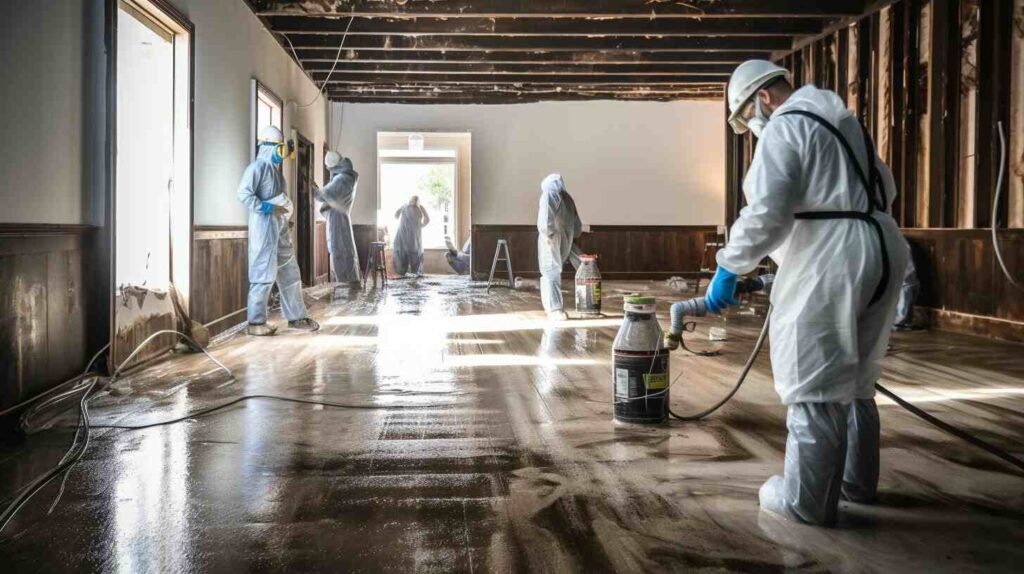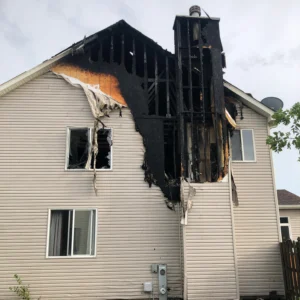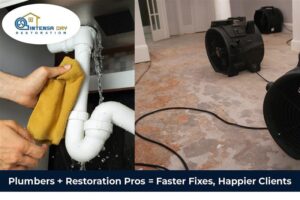Blogs
Water Damage Cleanup for Plano Apartments: Quick Fixes and Professional Help

Water damage in apartments can be a nightmare, especially in a place like Plano, where weather events can vary widely. Leaks, flooding, and burst pipes are common causes, each capable of leading to significant property damage if not managed quickly. in this post, Intensa Dry covers everything Plano apartment residents need to know about addressing water damage effectively, from do-it-yourself solutions for minor issues to knowing when professional assistance is necessary. Quick action can prevent mold growth, structural issues, and even health risks. Understanding the right steps can mean the difference between a small inconvenience and a costly repair.
Understanding Common Causes of Water Damage
Water damage in Plano apartments can arise from several factors, often due to weather conditions and everyday wear and tear. Burst pipes during unexpected freezes, backed-up drains, and leaky appliances are among the most common culprits. Additionally, Plano’s climate can experience heavy rainstorms, increasing the risk of water intrusion, especially for ground-floor units. Recognizing these potential risks is the first step toward preventative maintenance. Apartment residents can stay vigilant by regularly checking for signs of water damage, such as discoloration on ceilings and walls or musty odors. Addressing these signs early can often prevent extensive damage, helping renters avoid costly repairs and maintain a safe living environment.
Quick Fixes for Minor Water Damage Issues

When dealing with minor water damage, quick fixes can often save the day. For small leaks or spills, immediately blotting up standing water with towels can prevent moisture from seeping deeper. Portable fans and dehumidifiers are also useful for drying out wet spots and preventing mold growth. For localized leaks, using a water-resistant sealant can provide a temporary fix while waiting for professional repairs. Remember to inspect any nearby furniture or carpets, as these materials tend to hold onto moisture and could develop mold. While these quick solutions are valuable for minor issues, persistent or worsening water damage typically requires professional intervention.
Why Water Damage Shouldn’t Be Ignored
Ignoring water damage in an apartment can lead to significant consequences. Even minor leaks can escalate quickly, causing mold, mildew, and structural issues that threaten the apartment’s livability. Mold thrives in damp environments, and prolonged exposure can pose health risks, especially for those with respiratory conditions or allergies. Structural damage, such as weakened walls or warped flooring, can result in costly repairs and a reduction in property value. Moreover, unchecked water damage may affect adjacent apartments, leading to disputes and potential legal issues. By addressing water damage promptly, tenants can avoid health hazards and costly repairs while ensuring their apartment remains a safe, comfortable home.
The Importance of Acting Quickly with Water Damage
Prompt action is essential when it comes to water damage. The longer water is allowed to remain, the greater the likelihood of severe damage. Within minutes, standing water can begin to soak into carpets, walls, and furniture. After 24-48 hours, mold spores may start to develop, posing a health hazard to residents. Acting quickly by shutting off the water supply, soaking up water, and calling a professional can prevent further complications. In cases of widespread water damage, immediately contacting an emergency restoration service can save substantial time and cost. Fast response not only prevents additional damage but also mitigates health risks for the apartment’s occupants.
Choosing the Right Equipment for Water Damage Cleanup
Effective water damage cleanup starts with the right equipment. For minor issues, a good quality wet/dry vacuum can remove standing water efficiently. Dehumidifiers help control moisture, especially in humid environments like Plano, where mold can form quickly. Portable fans are essential for circulating air and speeding up the drying process. However, for extensive damage, industrial-grade equipment may be necessary. Restoration professionals use advanced tools like moisture meters, commercial dehumidifiers, and specialized vacuums to remove water and dry surfaces thoroughly. Renting equipment or hiring professionals with access to these tools can make a substantial difference in the quality and speed of water damage restoration.
When to Call Professional Help for Water Damage

While minor water damage can often be managed with quick fixes, certain situations demand professional expertise. When water damage involves sewage backups, flooding, or structural concerns, professional restoration services are essential. Experts can assess the extent of damage, remove contaminated materials, and use commercial-grade drying and dehumidifying equipment. Additionally, professionals can conduct mold remediation, which is often necessary after prolonged exposure to moisture. Calling in help also minimizes the risk of hidden damage, such as moisture trapped behind walls or beneath flooring. Overall, investing in professional services can save tenants from costly future repairs, ensuring that their apartment remains safe and structurally sound.
Water Damage Prevention Tips
Preventing water damage is often easier than repairing it. Plano apartment renters can take proactive steps to reduce the likelihood of water damage. Regularly checking for signs of leaks, such as discoloration on walls or ceilings, can help identify issues early. Cleaning drains and ensuring that appliances like washing machines and dishwashers are in good working order also minimizes risk. During Plano’s rainy season, renters should inspect windows and doors for proper sealing to prevent water intrusion. For long-term prevention, installing water sensors near potential leak sources, like sinks and water heaters, provides an added layer of protection, alerting residents to leaks before they escalate.
Water Damage Restoration Service
Professional water damage restoration services follow a structured process to ensure thorough cleanup and recovery. Initially, technicians will assess the damage, determining the extent and type of water involved. Next, they remove standing water using high-powered vacuums and begin drying with commercial-grade dehumidifiers and air movers. If mold has started forming, they may include mold remediation, using antimicrobial treatments to prevent further growth. Restoration also involves sanitizing affected areas to ensure safety. Finally, any damaged materials are repaired or replaced, restoring the apartment to its pre-damage condition. Hiring professionals ensures that every aspect of the cleanup is handled, offering peace of mind for renters and property owners alike.
Tips for Filing a Water Damage Insurance Claim
Filing a water damage insurance claim can be complex, but following a few steps can streamline the process. Start by documenting the damage thoroughly, taking photos and videos for evidence. Notify your insurance provider as soon as possible, providing all necessary details about the incident. Be clear about the cause of water damage, as some policies may not cover certain types, like gradual leaks or neglect. Keep all receipts for any temporary water damage repairs or replacement items. Working with a water damage restoration company that understands the claims process can also be helpful; they often provide documentation and estimates required by insurers to expedite the claim.
Recognizing Hidden Signs of Water Damage
Water damage isn’t always immediately visible. Hidden signs like musty odors, peeling paint, and warped floors can indicate moisture issues lurking beneath surfaces. In apartments, water often travels through walls, affecting areas far from the original source. Discolored spots on ceilings or walls, even if faint, are red flags of possible leaks. Likewise, any bubbling or softening in drywall might mean water damage inside walls. Early identification of these hidden signs allows tenants to take action before problems escalate. Regularly inspecting areas around sinks, windows, and under appliances can help prevent unnoticed damage from developing into a larger, more costly issue.
Dealing with Mold After Water Damage
Mold is a common aftermath of water damage, especially in humid climates like Plano. It typically starts forming within 24 to 48 hours after exposure to moisture, spreading quickly if left untreated. Black, green, or white spots on walls and ceilings are obvious indicators, but mold often hides in less accessible areas, such as behind walls or under carpets. Addressing mold promptly is crucial, as it can impact both health and property. Dehumidifiers and ventilation help control mold growth, but professional remediation is often necessary to ensure complete removal. Professionals use antimicrobial treatments and specialized equipment, ensuring that all mold traces are effectively eliminated for a safer living space.
Key Steps for Effective Water Damage Restoration
In multi-unit apartments, water damage can affect multiple tenants, making swift and coordinated action essential. First, tenants should alert building management immediately, especially if plumbing issues are causing the damage. Maintenance teams may need to inspect neighboring units to assess the extent of spread. In larger incidents, involving a water damage restoration company early can expedite recovery and limit damage. These professionals can work alongside building management to prevent water from affecting additional units, often through water extraction, drying, and preventive barriers. Coordinated response minimizes disruption and ensures faster, more effective restoration across the apartment building, keeping all tenants safe and reducing long-term repair costs.
Conclusion
Water damage in Plano apartments requires prompt and effective action to prevent further complications. From understanding common causes to knowing when to call professionals, renters can protect their apartments and health by addressing water issues early. While minor leaks might be manageable with quick fixes, more severe damage calls for expert help to ensure thorough cleanup and repair. Proactive measures, such as regular inspections and timely maintenance, can also reduce the likelihood of future incidents. Whether handling minor issues or facing major water damage, Plano residents can rely on these steps to maintain a safe, comfortable living environment.

